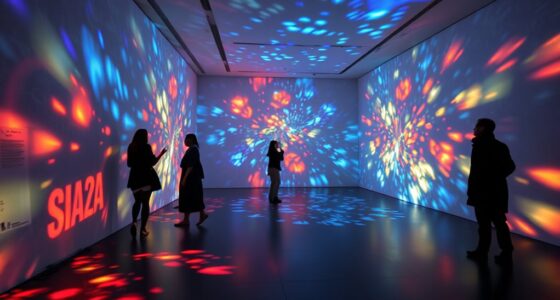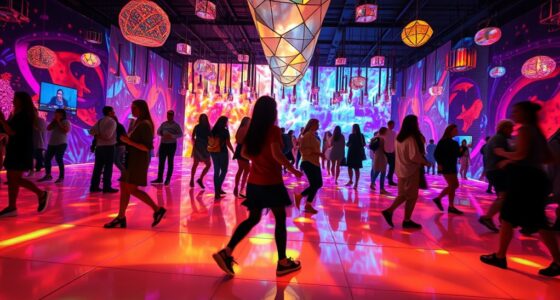Virtual reality is transforming art viewing by immersing you in digital environments that surround and engage you more deeply. It enables access to virtual museums and galleries from anywhere, breaking down barriers of distance and mobility. VR also enhances interaction, allowing you to explore artworks in detail and customize your experience. As this technology continues evolving, you’ll discover new ways to connect with art on a personal level and experience exhibitions like never before. Keep exploring to learn more about this exciting shift.
Key Takeaways
- VR creates immersive environments that allow viewers to explore artworks in a more engaging and detailed manner.
- It expands access to global audiences, enabling virtual visits to museums and galleries regardless of location or physical ability.
- Digital curation in VR enhances storytelling and highlights lesser-known works, offering personalized and multimedia-rich experiences.
- Interactivity in VR promotes active participation, deepening emotional connection and understanding of artworks.
- VR is transforming art viewing by making exhibitions more vibrant, flexible, and accessible, enriching the overall experience.

Have you ever wondered how virtual reality is transforming the way we experience exhibitions? It’s revolutionizing the art world by offering immersive experiences that go far beyond traditional viewing. With VR, you can step inside a digital environment where artworks aren’t just displayed on walls—they surround you, inviting you to explore every detail and nuance. This level of immersion creates a more engaging and personal connection to the art, making each visit feel like a unique journey rather than a passive glance. As a visitor, you’re no longer confined to the physical space of a gallery; instead, you can wander through vast virtual museums, walk around sculptures, or even enter scenes that transport you to different times and places. This capability hinges on digital curation, which involves meticulously selecting and arranging digital assets to craft compelling and coherent virtual exhibitions. Curators leverage this technology to enhance storytelling, highlight specific themes, or showcase lesser-known works that might not fit into traditional exhibition spaces.
VR’s ability to facilitate digital curation means that exhibitions can be tailored to individual preferences or educational goals, making the experience more meaningful and accessible. Imagine exploring a virtual exhibit designed specifically for your interests—perhaps a focused journey through Renaissance art or an immersive plunge into contemporary installations. The curation process becomes more dynamic, allowing curators to incorporate multimedia elements like audio guides, videos, or interactive components that deepen your understanding. This flexibility also democratizes access to world-class exhibitions, enabling anyone with a VR headset to experience masterpieces from across the globe without leaving their home. It’s a game-changer for museums and galleries seeking to reach broader audiences, especially those who might face barriers like distance, cost, or physical limitations. Additionally, immersive technology can simulate high-fidelity visuals, further enriching the viewing experience.
Furthermore, these immersive experiences foster a sense of participation that traditional exhibitions often can’t provide. You’re encouraged to engage actively with the content—perhaps by zooming in on intricate brushstrokes or examining the context behind a piece—all within a carefully curated digital environment. This interactivity increases retention and emotional impact, making art more memorable. As VR continues to evolve, so will its role in digital curation, allowing curators to craft more sophisticated, multi-layered stories that captivate and educate. Ultimately, virtual reality isn’t just about viewing art; it’s about experiencing it in a way that’s more vibrant, personalized, and accessible than ever before.
Frequently Asked Questions
How Does VR Impact Traditional Art Gallery Experiences?
VR transforms traditional art gallery experiences by making them more engaging and accessible. You can explore artworks through immersive storytelling, which deepens your understanding and emotional connection. Augmented reality enhances your visit by overlaying additional information or interactive elements. This technology allows you to virtually walk through exhibits from anywhere, offering a personalized experience that complements or even surpasses physical gallery visits, broadening your appreciation of art.
Can VR Exhibitions Replace Physical Museums Entirely?
VR exhibitions can’t fully replace physical museums because they lack the tactile experience and digital nostalgia many visitors cherish. While VR offers immersive storytelling and broad access, it can’t replicate the unique atmosphere of stepping into a historic gallery. You might enjoy engaging with art virtually, but for a complete, sensory-rich experience, physical museums still hold a special place in your cultural journey.
What Are the Costs Involved for Artists and Institutions?
You face significant costs when creating VR exhibitions, including equipment, software, and development. A thorough cost analysis helps identify expenses and potential funding challenges. As an artist or institution, you might struggle to secure sufficient funding, especially for high-quality VR setups. These costs can be a barrier, requiring you to explore grants, partnerships, or innovative funding sources to sustain your virtual projects and make them accessible.
How Accessible Are VR Exhibitions to People With Disabilities?
You’ll find VR exhibitions increasingly accessible thanks to assistive technology like screen readers and haptic feedback, which help bridge accessibility barriers. While some experiences may still pose challenges, developers are actively working to improve inclusivity. As a result, more people with disabilities can enjoy immersive art, making VR exhibitions a promising, evolving space that endeavors to be welcoming for everyone.
What Are Future Trends in Virtual Reality Art Displays?
You’ll see future virtual reality art displays becoming more immersive with enhanced storytelling features, blending augmented reality seamlessly into the experience. Expect richer, interactive environments that adapt to your movements and preferences, making art viewing deeply personal. As technology advances, VR will incorporate more haptic feedback and AI-driven narratives, transforming passive viewing into active exploration. This evolution will make art more engaging, accessible, and emotionally resonant for everyone.
Conclusion
As you put on the VR headset, you’re transported into a boundless gallery, where colors shimmer and sculptures seem to breathe. The digital domain surrounds you, dissolving walls and opening new worlds of artistic expression. With each step you take, you’re immersed in a universe where art comes alive—vivid, dynamic, and personal. Virtual reality isn’t just changing how you view art; it invites you to become part of its endless, breathtaking canvas.









